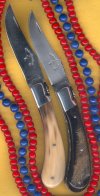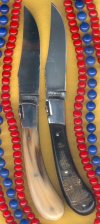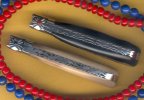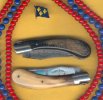Have had my eye on this pattern for several months
Finally gave myself a week to consider ebony, buffalo bark or classic cattle bone
Pulled the trigger on this one today and it may be here as soon as Wednesday
The waiting and watching begins ...
Capuchadou 12 cm Classic Cattle Bone from Fontenille Pataud
Overview: This traditional French folding knife is the perfect addition to any picnic basket. Take it with you on your next adventure and of course, don't forget the wine, the cheese, and the saucisson sec.
Before the development of the Laguiole in the 19th century, French shepherds carried a knife called the "Capuchadou" (or "capujadou"). This knife was used for all daily tasks, from preparing lunch to care for their flocks of sheep. The four leaves clover was added for good luck.
Consider this: This knife was entirely handmade in Europe's capital of cutlery "Thiers." The “Gilles®” Fontenille Pataud collection of knives are considered by many to be some of the best pocket knives money can buy. All Knives offered by Gilles are entirely made by a single craftsman from start to finish ensuring pride of ownership of the final piece. 100% Made in France
Technical aspects: The spring is made from 3 mm thick stainless steel Z20c13 and features a blade-stop that helps maintain the edge of the blade. The "Shamrock", as well as the handle's top, are hand-chased with a file: This denotes artisan quality, unlike mass-market knives that have welded springs and are machine decorated. The file work details create a unique knife, making each knife one of a kind.
Handle Material: Cattle Bone (Bovine, France). Note that it is not unusual to find areas of different shades of beige and small streaks of darker colors within the bone. These features only contribute to the uniqueness of such material.
Plates: 1.5 mm stainless.
Decorated Spring: 3 mm stainless - Hand file work
Blade Size: 9.4 cm (3.7")
Bade: Swedish Sandvik 14C28N stainless steel - 56 Hrc.
Handle Size: 12.3 cm (4.65")
Weight: ~ 120 grams (4.2 oz.)








